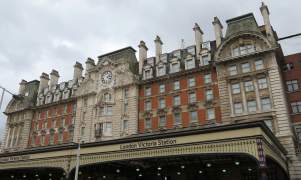
Victoria Station is having something of a makeover, with new underground passages under the main road and so forth, which is to be commended, and although there are years to go to completion, already the builders have cleaned the historic frontage of the station with its various sculptural adornments, so this seemed a good subject for sculpture of the month.
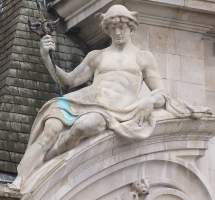
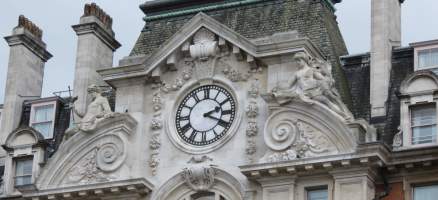
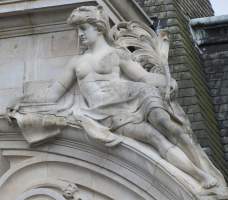 Victoria Station, sculpture on the 1898 block.
Victoria Station, sculpture on the 1898 block.
The placing of the bus station, and the works, make it difficult to get a view that does justice to the whole assemblage, but what we see is a collection of three rather different buildings, decreasing in age from right to left. The central block above the canopy, shown at the top of this page, is the main part of the station: behind the frontage is the 1862 structure built for the London, Chatham and Dover Railway and the Great Western Railway, with the arched train sheds behind by the architect John Fowler. But what we see from outside dates from 1898, a vast structure of 19 bays, 6 storeys above the double height station hall, and tall chimneys. In the centre at the top is a clock, surrounded with sculptural adornments in a free Baroque style, and sitting on the sides of the pediment are two large Portland stone figures, shown above. To the left is seemingly Hermes, the speedy messenger of the Gods, appropriate for a railway terminus. He lounges easily on the curved pediment, one hand resting on a fold of his drapery – he is almost nude – the other holding a bronze staff with a little winged ornament which likely has slid down from the top to rest against his hand. He wears a winged helmet, rather worn. A figure of restrained power and considerable skill – but who was the artist?
His companion on the other side is a female, semi-draped, holding a stylised palm branch, and wearing a hood made from a lion or panther’s head. Rather splendidly exotic, with superb modelling of the torso.
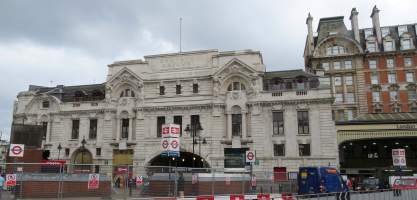 The Edwardian Southern Railway block, and behind on the right, the 1898 building.
The Edwardian Southern Railway block, and behind on the right, the 1898 building.
To the left and somewhat forward is the Southern Railway block, a stone-fronted Edwardian block by the architect A. W. Blomfield, with excellent mermaid caryatids on the towers to left and right of the main entrance, at third floor level, by the sculptor Henry C. Fehr. There are four of these, shown below prior to cleaning, as the cleaned statues do not yet have enough dirt on them to give full contrast and depth and look at their best.
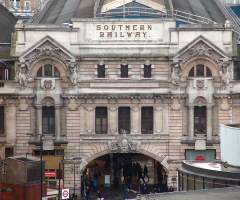 Central portion of the Southern Railway block.
Central portion of the Southern Railway block.
They are of the double-tailed variety, charmingly scaly, with curious triple finned ends to each tail, and with further fins at the waist forming a skirtlike covering. Each one has a similar pose, with one arm thrown across the head, to form the support that makes her a caryatid, the other stretched out along the curve of the arched lunette, with its garland of shells. They all gaze downward, hooded behind their hair, which sweeps back and behind to drift down wavily to below the waist. (For lots more mermaids, see this page.) And each has next to her the prow of a ship – one pair with sailing ships, the other with a steamship and perhaps a trireme. The poses are very similar, but the figures differ in minor detail. All are beautiful, and characteristic of the work of Fehr, one of the best New Sculptors who made something of a specialty of the sensuous female nude.
We turn to the more minor carving on this building. Over each of the two arches and under the pediments which the mermaids support, are festoons of shells which meet at the keystone position with a large cartouche, very swirly art nouveau, with behind it crossed arms, including a Neptune-like trident. Below each lunette window, thus between the mermaids, hangs a large wreath of summer fruits, bound with ribbons and with some upper support which again reminds us of the date of this work.
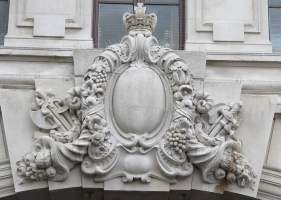 Keystone over the main entrance.
Keystone over the main entrance.
At the top of the arch of the main entrance in the keystone position is a cartouche, ringed by a border of fruit and flowers with the odd sea shell, with a crown on top, a cornucopia to each side, with above it a small collection of swords and axes encircled by a wreath. To the left of the main entrance, as we look at it, is a third range, which extends round the corner along the beginning of Wilton Road. There is a continuation of the sculptural adornments, though nothing so ornate as the principal front. Cherubic heads, festoons and fructifying accoutrements are mostly in the pediments.
Sculpture and tilework from the interior.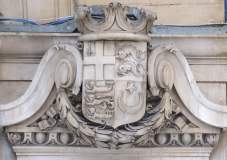
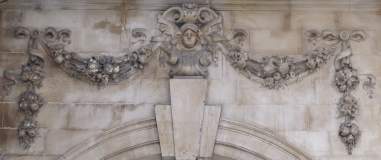
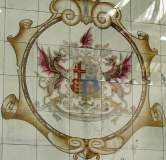
There is further and similar ornament inside, but less of it. As well as the carving, we may note the printed tile map of the stations served by the London, Brighton and South Coast railway, with a rather nice coat of arms depicting spiky red-winged dragons.
Grosvenor Hotel decoration, by Daymond and Son, and the two standing figures.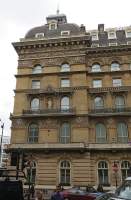
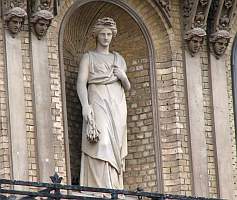
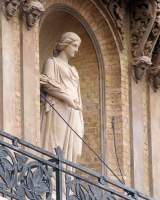
To the right hand side as we look at the group of buildings is the Grosvenor Hotel, which dates from the time of the original building of the station, thus 1860-61. The architect was James Thomas Knowles, and his conception is a splendidly ornate high-Victorian building, clad in warm-coloured Bath stone and similarly coloured brick, with details in a much discoloured paler hue. There is profuse carving, with lions’ heads and garlands at the first floor level, leafy balconies above, then a strip of ornately carved foliage with roundels containing portrait heads. Next floor up, we have two niches with standing full figures of classical girls, one holding leaves, the other corn, and to the sides of the niches, and all the way along, are brackets with identical female heads forming bosses at their base, medieval style. Higher up still, a second band of leaves with further medallions bearing ideal heads representing Nations of the Earth.
Nations of the Earth, by J. Daymond and Son.
There are further details to be spotted – pilasters with acanthus leaves, further leafy designs on the iron railings, small pediments with more acanthus with very deep cutting, Italianate entablatures, and so forth. The medallions and most of the carving at least is by Daymond and Son; I do not know if that firm was also responsible for the two standing figures.
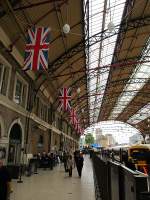 Interior view of one of the arched train sheds.
Interior view of one of the arched train sheds.
Previous month (June 2012) // next month (Aug 2012)
Sculptors // Sculpture in London
Visits to this page from 1 Jul 2012: 20,706